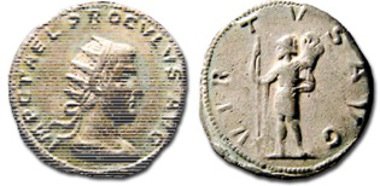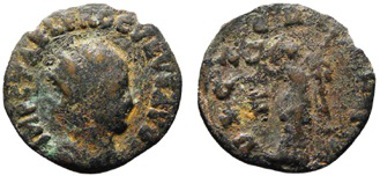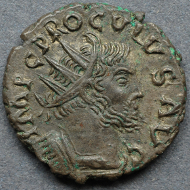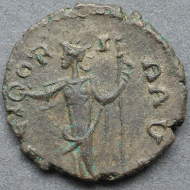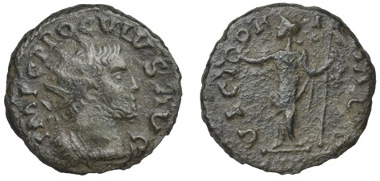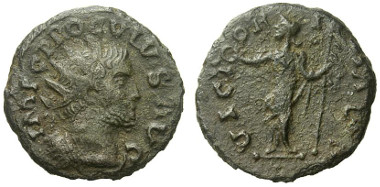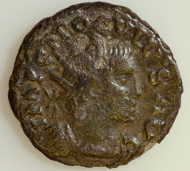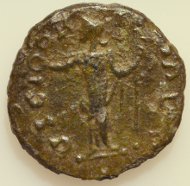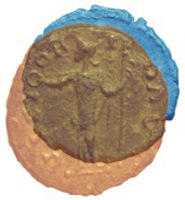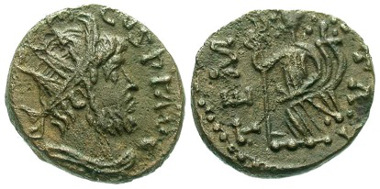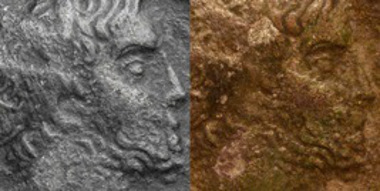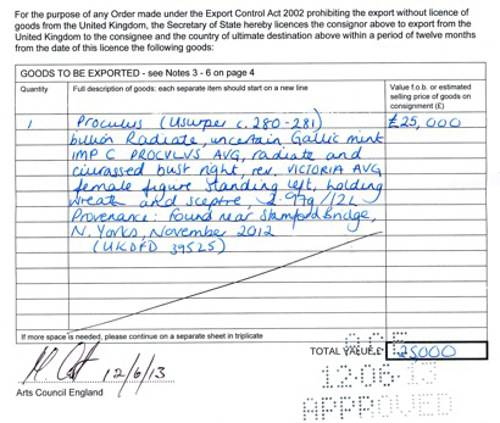by Umberto Moruzzi and Fabio Scatolini
Proculus, in full Titus Ilius Proculus, was, according to ancient sources, a usurper between 280 and 281 A.D. in the reign of the emperor Marcus Aurelius Probus. A native of Albingaunum (modern Albenga), where his family belonged to the local nobility, he became wealthy by trading in cattle and slaves, which he got by brigandage. At Albenga he lived with his wife Vituriga and his son Erennianus, after a brilliant military career in which he was appointed to the rank of tribune in several legions.
The writer of the Vita Probi in the Historia Augusta states that in 280 A.D. he accepted the purple offered to him by the people of Gaul and took as colleague another usurper, the tribune Bonosus. According to some sources this happened at Colonia Agrippina, according to others, at Lugdunum.
Confirmation on the identification of the place of his elevation comes from the known coinage in his name, which, as we will see later, indicates Cologne as the most probable location.
Proculus is said to have guaranteed security to the inhabitants of the province by defeating the Alamanni. This information from the Historia Augusta shows how the usurpation was itself a response to the need felt by the population living close to the borders and threatened by enemies, to have the emperor and his army close at hand.
The return of the legitimate emperor to the region forced Proculus to retreat northwards, where he sought help from the Franks, who instead betrayed him and handed him over to Probus. The emperor condemned Proculus to death, but the family and assets of the usurper were spared.
The historical context
After Aurelian’s victory over Tetricus in 274 A.D. which ended the Gallic Empire and brought back under Roman control the territory formerly held by the usurper, troops stationed on the limes were withdrawn in anticipation of war against the Goths, a decision which in reality opened the gates to invasion.
Already in 275 Aurelian had crossed the Alps, according to the Historia Augusta, to defend parts of Rhaetia, in particular Augusta Vindelicum which was besieged by the barbarians. At the end of Aurelian’s reign problems persisted in those areas bordering the Rhine which were no longer defended by the usurpers of the Gallic Empire.
The same area continued to be a concern in the reign of Tacitus (275-276 A.D.): the staff of the Lugdunum mint were transferred to Arelate.
Barbarian attacks against the Rhine area, Gallia Lugdunensis, and the north of Italy were a problem Probus (276-282 A.D.) would have to confront, after defeating the Goths on the Danube and in Asia Minor.
Antoninianus showing, on the obverse, Probus in military dress. Ex Pecunem & Gitbud & Naumann, Auction 9 03/11/2013; Probus, antoninianus: VIRTVS PROBI AVG, helmeted, radiate and cuirassed bust of Probus left, holding with his right hand a spear leant against his right shoulder, with his left a shield; SECVRITAS PERP, Securitas stands facing forwards, her head turned to the left, and leaning on a column. Ticinum mint. RIC 526, C 617.
In numismatic circles, the fact that a great army was put together to repel these invasions is highlighted by a typological series of busts in which Probus is shown in military dress.
After a series of engagements and victories, Probus succeeded in driving the Germans back across the River Neckar and secured the entire Rhine area, in part by forging a pact with the existing population of the Agri Decumates who had been settled there for some time.
Various hypotheses have been put forward to identify the date for the end of these military operations in Gaul, amongst which the beginning of 278 seems the most plausible.
Shortly after the victories of Probus in Gaul the usurper Proculus makes his appearance on the stage of history. Proculus, who, as we mentioned earlier, was in command of the military forces defending the territories around the Rhine against the Alamanni. It seems very likely, therefore, that Probus (who at that moment was again in the East quelling the revolt of Saturninus) was seen as failing to give Gaul what it hoped for. The Western provinces felt the need to have an emperor always close at hand to defend them without delay from repeated and damaging invasions. This was not a new situation in this part of the Empire; from 260 A.D. there had been several usurpations amongst which that of Postumus had been the most important. The acclamation of Proculus as emperor can be seen therefore as historically comprehensible and very possible.
The sources and the coins
The only evidence for the existence of Proculus were, until a few years ago, the later sources, detailed here, which mention him together with Bonosus.
Image of a fantasy coin of Proculus, taken from J. de Strada, Epitome Thesauri Antiquitatum, hoc est, Impp. Rom. Orientalium et Occidentalium iconum, ex antiquis numismatibus quàm fidelissimè delineatarum: ex musaeo Iacobi de Strada Mantuani antiquarii, (Lyon, 1553) p. 163.
- Aurelius Victor, Epitome de Caesaribus 37, 3: At the same time Saturninus in the East, and Bonosus at Cologne were killed by the army; for both of them aspired to power, having taken control of the army which they had led. (Simul caesis Saturnino per Orientem, Agrippinae Bonoso exercitu; nam utrique dominatum tentaverant, sumpta cui duces praeerant manu.)
- Eutropius, Breviarium 9, 17: Those who attempted to usurp imperial power, that is to say Saturninus in the East, and Proculus and Bonosus at Cologne, he defeated in many battles. (Quosdam imperium usurpare conatos scilicet Saturninum in Oriente, Proculum et Bonosum Agrippinae multis certaminibus oppressit.)
- Aurelius Victor, Epitome de Caesaribus 37, 2: He defeated Saturninus in the East, and Proculus and Bonosus at Cologne, who had been proclaimed emperors. (Iste Saturninum in Oriente, Proculum et Bonosum Agrippinae imperatores effectos oppressit.)
- Orosius, Historiarum adversus paganos libri septem 7, 24, 3: He then waged two very bloody civil wars: one in the East, in which he overthrew and captured Saturninus strong in absolute power, the other at Cologne, where he defeated Proculus and Bonosus in a series of great battles, and killed them. (Bella deinde civilia equidem plurimo sanguine duo gessit: unum in Oriente, quo Saturninum tyrannide subnixum oppresssit et cepit, aliud, quo Proculum et Bonosum, apud Agrippinam magnis proeliis superatos, interfecit.)
- Chronica Minora saec. IV. V. VI. VII, edidit Theodorus Mommsen, vol. 1, 11, 13, Monumenta Germaniae Historiae. Auctores Antiquissimi, München 1981 (Berlin 1892), p. 522, 52-3: Under whom Saturninus, Proculus and Bonosus were tyrants. (Sub quo Saturninus, Proculus et Bonosus tyranni fuerunt.)
- Historia Augusta, Vita Probi 18, 4-5 : For he overcame Saturninus, who had seized imperial power in the East, in a series of battles and with renowned courage …Then, when Proculus and Bonosus seized imperial power at Cologne in Gaul … he defeated them. (Nam et Saturninum, qui Orientis imperium adripuerat, variis proeliorum generibus et nota virtute superavit… Deinde, cum Proculus et Bonosus apud Agrippinam in Gallia imperium adripuissent… vicit.)
- Historia Augusta, Quadrigae tyrannorum I, 1: I know that many have said nothing about the most insignificant of tyrants. (Minusculos tyrannos scio plerosque tacuisse.)
Forged specimen from the 16th century cast by hand by the Illustrator of the Historia Augusta. 1579: H. Goltzius, Thesaurus rei antiquariae huberrimus; ex antiquis tam numismatum quam marmorum inscriptionibus pari diligentia qua fide conquisitus ac descriptus, & in locos communes distributus, Anversa 1579; 1579: A. Occo, Impp. Romanorum numismata a Pompeio Magno ad Heraclium, Anvers 1579; 1595: F. Orsini, Fragmenta Historicorum, Anversa, 1595; 1647: J.-J. Chifflet, Vindiciae Hispanicae, in quibus arcana regia publico pacis bono luce donantur, Anvers 1647; 1683: F. Mezzobarba, Imperatorum Romanorum Numismata, Milan 1683; 1730: F. Argelati, Imperatorum Romanorum Numismata, a Pompeio Magno ad Heraclium ab Adolfe Occone olim congesta Milan 1730; 1718: A. Banduri, Numismala Imperatorum Romanorum a Trojano Decio ad Palaeologos Augustos, Paris 1718; 1791: H. Tanini, Numismatum Imperatorum Romanorum … ab A. Bandurio editorum Supplementum, Rome, 1791. Source: S. Estiot, Atti del XIIe colloque international de l’HA, 2-4 juin 2011 Nancy, Probus et les ‘tyrans minuscules’, Proculus et Bonosus. Que dit la monnaie?, in the press.).
We agree with Sylviane Estiot (to her we owe the most recent publication on the cataloguing of the coinage of this period: S. Estiot, Monnaies de l’Empire romain, XII.1 D’Aurélien à Florien (270-276 après J.C.,) Paris 2004.), one of the top experts in the coinage of the Gallic territories of the Empire, that an examination of the coins known from the 16th to the 20th century in the name of Proculus confuses the historical record: not one of them is either authentic or ancient.
Another specimen of a cast produced from the same counterfeit 16th century matrices. The coin is preserved at the Bibliothèque Nationale in Paris. Source: S. Estiot, Atti del XIIe colloque international de l’HA, 2-4 juin 2011 Nancy, Probus et les ‘tyrans minuscules’, Proculus et Bonosus. Que dit la monnaie?, in the press.).
A third specimen cast originating from the matrices of the 16th century forgery. The coin is preserved at Lyon. Source: S. Estiot, Atti del XIIe colloque international de l’HA, 2-4 juin 2011 Nancy, Probus et les ‘tyrans minuscules’, Proculus et Bonosus. Que dit la monnaie?, in the press.).
A copy forged in the modern period (Modern forgery: Gallienus, bronze, issued for 7th consulship (266), re-engraved, [GALLIENVS AVG], VICTORIA AET; RIC 297var., Cunetio 1240 (27 ex.), London, preserved at the British Museum.), obtained by engraving the obverse of an antoninianus of Gallienus with a burin. Source: S. Estiot, Atti del XIIe colloque international de l’HA, 2-4 juin 2011 Nancy, Probus et les ‘tyrans minuscules’, Proculus et Bonosus. Que dit la monnaie?, in the press.).
The first known antoninianus of Proculus. Auction sale Aufhäuser 8, 9-10/X/1991, 640, (München 1991/350). Foto (c) Andreas Pangerl, www.romancoins.info
To make the acquaintance of the first genuine coin in the name of Proculus we would have to wait until 1991, when a radiate issue appeared for sale in a public auction bearing his name and proving for the first time that such coins had existed.
The coin, for various reasons that we will explain, makes it certain that Proculus had no access to the official mint. For earlier scholars (H. Mattingly, E. A. Sydenham, The Roman Imperial Coinage, Londra 1933) the official mint was Lugdunum (Lyons), according to Estiot (S. Estiot, Atti del XIIe colloque international de l’HA, 2-4 juin 2011 Nancy, Probus et les “tyrans minuscules”, Proculus et Bonosus. Que dit la monnaie?, in the press) the workforce of this mint was transferred to Arelate (Arles). Wherever it was located, it was the only Western mint still functioning at that time.
The first original specimen of a coin struck in the name of Proculus, an antoninianus or radiate (diameter 18 mm., weight 3.46 gr.), appeared on 9 October 1991 at Munich, in a public auction hosted by Bankhaus Aufhauser (lot 640, auction 8) and sold for 94,000 Deutschmarks.
The discovery came during the cleaning of a hoard recovered in England by the British coin dealer Richard Swan, and was found together with other late Roman coins.
The coin had on the obverse a radiate, draped and cuirassed bust of Proculus, with the legend IMP C PROCVLVS AVG; on the reverse the legend VICTORIA AVG and the personification of Victory holding in her right hand a wreath and in her left a sceptre. The example, in silvered bronze, looking very much like the antoniniani of the reign of Probus with some traces of patina removed, is in Extra Fine condition.
On 7 November 2012 a second example of the antoninianus of Proculus came to light close to Stamford Bridge in Yorkshire, as a result of searches with metal detectors by Mark Hildreth and Colin Popplewell, two detectorists with more than twenty years’ experience.
Mr. Popplewell has said that at the moment of discovery neither he nor his friend recognised the emperor’s features. They photographed the coin out in the field and posted the image on a site used by metal detector specialists.
They then started to get messages back from people telling them that they really should take the coin to be professionally valued, as it seemed to be something truly exceptional.
The coin was found to be of the same type as the previous one; in addition the obverse and the reverse were in fact minted from the same pair of dies. The weight and diameter of the second example are: weight 2.96 grammes and maximum diameter 19.27 millimetres.
Image from the DNW auction catalogue of the second known example of an antoninianus in the name of Proculus. Catalogue DNW 10 April 2013 lot 694.
After its discovery and identification, the coin was offered for sale at auction by Dix Noonan Webb (Dix Noonan Webb, 16 Bolton St. Piccadilly, London W1J 8BQ) of London on 10 April 2013 as lot no. 694 (“Proculus (Usurper c. 280-281), billon Radiate, uncertain Gallic mint, IMP C PROCVLVS AVG, radiate and cuirassed bust right, rev. VICTORIA AVG, female figure standing left, holding wreath and sceptre, 2.97g/12h (Vagi, Coinage and History of the Roman Empire, 2470). Very fine, dark tone, edge a little ragged; only the second known coin of this usurper, extremely rare and the only example available to commerce £50,000-70,000”) with an estimate of £25,000 sterling (plus the buyer’s fee).
Image from the Numismatik Lanz auction catalogue of the same example of an antoninianus in the name of Proculus. Numismatik Lanz Auction 9 December 2013 lot 357.
The same coin was offered again at auction in Germany at Numismatik Lanz in their auction no.157 of 9 December 2013 when it made 48,800 euro including the buyer’s fee.
The exceptional nature of this second example is directly related to its provenance and archaeological context, and to its original patina, practically intact; in addition, it is the best confirmation also of the authenticity of the first coin, which is now in the collection of the Staatlichen Münzsammlung München, in Munich.
High quality photograph of the obverse of the same example on the occasion of the sale by auction at Numismatik Lanz. Foto (c) Andreas Pangerl, www.romancoins.info
This second example appears to have been minted from the same pair of dies, with the reverse struck more centrally than in the first example, and shows other, previously unknown details of the minting.
High quality photograph of the reverse of the same example on the occasion of the sale by auction at Numismatik Lanz. Foto (c) Andreas Pangerl, www.romancoins.info
On careful consideration the coin is shown to be authentic together with its patina; in our opinion, the first example also is authentic.
The first coin was already considered authentic by Estiot in her intervention on the occasion of the Conference on the Historia Augusta held at Nancy in 2011; according to the French researcher the Proculus coin was unique in its period, a reference to the “tyranni minusculi”, which could be said to be genuine.
The Mint
We cannot be sure where the coins of Proculus were minted: Lugdunum was not accessible, Cologne and Trier were closed in 274. (S. Estiot, Une campagne germanique de l’empereur Probus: l’atelier de Ticinum en 277-278, Genève 2006, pp. 209-229. According to Estiot, the staff of the Lugdunum mint were transferred to Arelate, an event supported by the fact that on coins there is a change from mint mark L to mint mark A.) It is probable that Proculus had availed himself, for the issuance of his coinage, of an irregular Gallic mint which, from 274, had been producing imitative antoniniani to sustain the local money supply and the army.
The workmanship of the two known coins, the silvering and the high quality design allows us to hypothesis that the production should be attributed to the former workforce of the Cologne mint.
Antoninianus in the name of Tetricus issued by the Cologne mint. Auction sale A. Tkalec AG May 2010 lot 409.
The style of this coinage in fact is very close indeed to the regular issues in the name of Tetricus from the Cologne mint.
This thesis of an attribution to a mint in the area of Cologne appears to be supported by a passage in the Historia Augusta, in the Vita Probi, which states: “For he overcame Saturninus, who had seized imperial power in the East, in a series of battles and with renowned courage … Then, when Proculus and Bonosus seized imperial power at Cologne in Gaul … he defeated them”. (Historia Augusta, Vita Probi 18, 4-5: Nam et Saturninum, qui Orientis imperium adripuerat, variis proeliorum generibus et nota virtute superavit… Deinde, cum Proculus et Bonosus apud Agrippinam in Gallia imperium adripuissent… vicit.)
We do not agree with Hubert Lanz who, in his comment in the catalogue when Numismatik Lanz put the second known example up for auction, speculated that the mint would be situated in Britannia as both the coins originated from finds in England.
A detailed comparison between the style of the coins of Proculus and the coins of Carausius (another usurper who seized power in Britannia, between 286 and 293 A.D.) highlights the remarkable stylistic and technical differences between the two types, which are so great as to exclude a British origin for the coins of Proculus.
The distance between the findspot of the coin and the area where it was minted is not excessive. Finds of antoniniani in the name of Gallic usurpers are, in fact, common in Britain.
Comparisons and reflections on the two coins
A careful analysis of the two coins shows them to be original, that is produced in the historical period of the usurper.
The reasons that confirm this proposition are:
- The style of minting is perfectly consistent with the coinage of the period.
- The production technique: on analysis, it is certain that the two coins were produced with the minting techniques of ancient times and in the same way as coins produced around 280 A.D.
- The dies: the two coins were produced from the same pair of dies. This fact is a further proof of the authenticity of the two coins. Certain details are emphasised: the presence of a slight break in the reverse die under the right arm of Victory; on the reverse of the first coin, some of the letters of the legend, the base of the Victory and the exergue are not present, in contrast to the second example.
We have superimposed the images of the two coins in order to verify that they are indeed from the same dies; as you can see in the following pictures the result was positive. The first coin was highlighted with a blue colour and the second with a brown colour. Where the superimposition gives effectively a perfect match, this shows clearly as a green colour.
Antoninianus from an irregular mint in the name of Tetricus. Forum Ancient Coins online shop.
A final comment is related to the technique of the design of the dies: the base of the Victory on the reverse is designed as a line joining two points; by comparing this detail with a contemporary antoninianus in the name of Tetricus, from an irregular mint, we notice that the base on the reverse is produced with the same technique.
The metal: the first coin, preserved at the museum in Munich, cleaned and bright with the almost complete removal of its patina, shows its metal as it was originally designed, in silvered bronze, absolutely compatible with the appearance of the antoniniani minted at Cologne and more generally with those in the name of the emperor Probus.
Image of the second example before and after its inclusion in the Numismatik Lanz sale: in the second image the silvering can be seen underlying the patina.
The second coin, while completely covered in patina, shows at two points on the obverse, on the neck of the emperor and in a slight area of loss on the forehead which occurred in the period between the first and second auctions, clear signs of underlying silvering.
Detail of the obverse of the first known example of Proculus.
The patina: the first coin, as mentioned above, has been the subject of cleaning, but still features very slight traces, certainly original, of green patina; the second is completely covered with its original patina.
Conclusions
We can state here beyond any reasonable doubt that the two coins in the name of Proculus, the one preserved in the museum at Munich and the other recently sold at the Numismatik Lanz auction, should be considered original: our analysis of the two coins allows the one coin to authenticate the other.
This is also the opinion of Estiot, one of the greatest authorities on Romano-Gallic coinage, and of the numismatic community, which includes academics together with the whole world of enthusiasts, scholars, collectors, and numismatic dealers.
The sole exception to this opinion is from Roger Bland, Keeper of the Department of Prehistory and Europe, responsible for the Portable Antiquities Scheme and for the Museum’s operation of the Treasure Act. In an interview with a newspaper in November 2012 (“History-changing coin or a 15C forgery? Debate over ‘Roman’ artefact found in field by metal-detecting friends”, Daily Mail 16 November 2012) he expressed an opinion condemning both the coin found in Yorkshire and the one now at the Munich museum as fantasy coins produced in the 16th century or later.
The numismatic world remains perplexed at this statement, because all the known imitations are distinctly different to these two examples and are obvious forgeries. It is even more surprising that Roger Bland, who was a curator in the Department of Coins and Medals at the British Museum until 2003, felt able to deliver such a judgment without having had sight of the coin, basing his opinion exclusively on a simple photo.
In addition, his assertions were only reported in the popular press and did not form the basis of an academic article. It is impossible to believe that in the 15th century or later a forger would be able to produce a counterfeit of such quality, in a style so in accordance with what we would expect from original coins, a forger whose coins were so right in every particular, and who would be capable of producing such convincing patinas, corrosion and silvering.
Bland also cites, unconvincingly, the comment of H. Mattingly and E. A. Sydenham in Roman Imperial Coinage (pag. 579: “Of Proculus no genuine coins are known, but a few pieces bearing the name of Bonosus deserve consideration. Like so much of the local coinage of Gaul, they are blundered.”) about the lack of evidence for any original coins of Proculus. This was certainly true when their work was published in 1933, but that was more than 70 years ago, well before the discovery of the first example. He also claims, falsely, that both the known examples were found as single coins, which in fact is true only of the more recent discovery. The first is known to have come from a hoard of 3rd century Roman coins found in Britannia and cleaned up by the English dealer Richard Swan. We find the comments of Richard Bland hard to square with a serious academic opinion.
There is a strong analogy with the history of the two antoniniani of Domitianus II. For more than a century the first known coin of this Gaulish usurper, found in France inside an amphora in 1900, was widely considered to be a forgery – up to the moment a second example was found in another hoard discovered in England in 2003.
The present Keeper and the curators of the Department of Coins and Medals at the British Museum have not confirmed his imaginative thesis.
Details of the Arts Council’s export licence.
The only official opinion from an English authority is the one issued by Arts Council England, which on 12 June 2013 issued an export licence (PAU/00206/13), where the coin is fully described, with details of its provenance and find date.
The two coins now confirmed as authentic have an exceptional historical value which allows us to see as real this previously shadowy character from history.
Umberto Moruzzi is numismatist and owns the rare-coin shop Moruzzi Numismatica.









